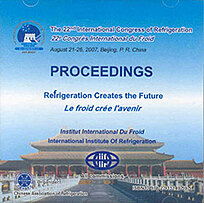
Résumé
At present, it was important that the safety, both national and international, for food products was of optimal quality. Once a food was preserved and packaged, it was not stable forever. Each food system slowly decayed or deteriorated. Temperature was the most important factor affecting the quality and safety of food during distribution and storage. Dairy products are among those that deteriorate if stored and distributed under inappropriate conditions. This work mainly aimed at investigating quality of dairy products in the cold chain. The relationship between quality and storage time on dairy by biochemical means were studied. The effects of different storage conditions on the quality of dairy products were also investigated using an electronic time-temperature indicator (ETTI). The device would predict the remaining shelf life and trigger an alarm when abnormal conditions were encountered. The remaining shelf life of dairy was obtained under the non-isothermal conditions, whose difference of results between measurement and biochemical analysis was less than 0.5 days. ETTI would appropriately indicate the remaining shelf life. It was better than the product date and significant to improve the cold chain for food.
Documents disponibles
Format PDF
Pages : ICR07-C2-619
Disponible
Prix public
20 €
Prix membre*
Gratuit
* meilleur tarif applicable selon le type d'adhésion (voir le détail des avantages des adhésions individuelles et collectives)
Détails
- Titre original : Experimental study on the shelf life of dairy products by ETTI.
- Identifiant de la fiche : 2008-0291
- Langues : Anglais
- Source : ICR 2007. Refrigeration Creates the Future. Proceedings of the 22nd IIR International Congress of Refrigeration.
- Date d'édition : 21/08/2007
Liens
Voir d'autres communications du même compte rendu (839)
Voir le compte rendu de la conférence
Indexation
-
Thèmes :
Chaîne du froid, interfaces;
Lait et produits laitiers - Mots-clés : Chaîne du froid; Chine; Température; Produit laitier
-
Maîtrise des températures et traçabilité pour l...
- Auteurs : TREHOUT B., PERRAMANT C.
- Date : 11/10/2000
- Langues : Français
- Source : Les Rencontres du Savoir-Faire. Que mangera-t-on demain ? Que produira-t-on ? Synthèse des actes + annexes + revue de presse.
Voir la fiche
-
Towards the implementation of a sustainable col...
- Auteurs : EVANS J., KAZI B. K., MUNSHI F., ALLOUCHE Y., COLOMBO I.
- Date : 21/08/2023
- Langues : Anglais
- Source : Proceedings of the 26th IIR International Congress of Refrigeration: Paris , France, August 21-25, 2023.
- Formats : PDF
Voir la fiche
-
Mapping of cold chain in Nepal
- Auteurs : RAJ DHAKAL P., WIDELL K. N., HAFNER A.
- Date : 06/04/2018
- Langues : Anglais
- Source : 5th IIR International Conference on Sustainability and the Cold Chain. Proceedings: Beijing, Chine, 6-8 avril 2018
- Formats : PDF
Voir la fiche
-
Temperature monitoring and modelling of chilled...
- Auteurs : OPATOVA H., LAGUERRE O., DERENS E., et al.
- Date : 19/09/1999
- Langues : Anglais
- Source : 20th International Congress of Refrigeration: Refrigeration into the Third Millennium.
- Formats : PDF
Voir la fiche
-
Maîtrise des températures et traçabilité pour l...
- Auteurs : SALVAT M., PEREZ M.
- Date : 11/10/2000
- Langues : Français
- Source : Les Rencontres du Savoir-Faire. Que mangera-t-on demain ? Que produira-t-on ? Synthèse des actes + annexes + revue de presse.
Voir la fiche
